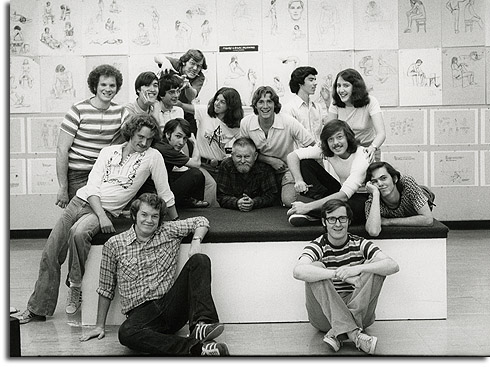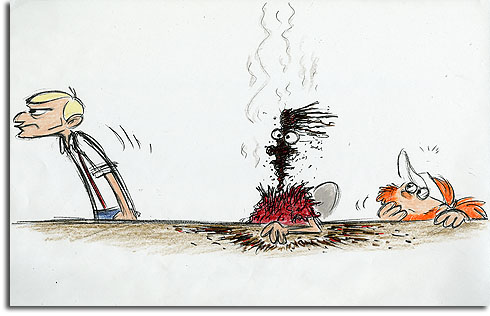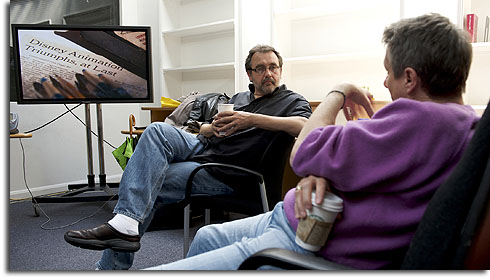The third of the new documentary releases we’re reviewing, Waking Sleeping Beauty looks at the animation renaissance that occurred at Disney in the late 1980s and early 1990s. Directed by longtime Disney producer Don Hahn, the film is an absolute cannot-miss must-see treat for any fan of animation. The quality of the film itself is enhanced on home video with a slate of great extras that really flesh out the story presented in the film.
The Film
 The 1975 graduating class at CalArts helped pave the way for the Disney renaissance. Future animators of note in the class included John Lasseter, Brad Bird and Jon Musker
The 1975 graduating class at CalArts helped pave the way for the Disney renaissance. Future animators of note in the class included John Lasseter, Brad Bird and Jon MuskerIn my original review of the film from its theatrical release, I said that it is rather remarkable that Waking Sleeping Beauty exists at all. The odds were against such a complicated story being told, especially with the willing and apparently forthright participation of the principal players in the saga. The fact that Hahn and producer Peter Schneider (himself the former Disney studio head) were able to corral Michael Eisner, Jeff Katzenberg and Roy Disney into telling their stories becomes even more astounding when you begin to realize the level of acrimony that slowly ratcheted up on the Disney lot even as the animation unit continued to reach new levels of success.
I have said that The Boys: The Sherman Brothers’ Story was the very definition of bittersweet, and for the devout animation fan a sense of melancholy pervades Waking Sleeping Beauty as well. This is odd, as the film itself is a tale of triumph, renewal, and success, but for those who know how it would all eventually end, it’s rather like watching all the pageantry at the Titanic’s christening. And yet the course of the film follows Disney animation from its historic low point, with The Black Cauldron getting beat out at the box office by The Care Bears Film, to its greatest triumph with The Lion King. The film ends around the time Katzenberg departed the studio in 1994 following the death of Frank Wells, which is really when the wheels started to come off. Still, the overall story of the film is of a young generation of filmmakers re-building an empire against the odds, and the tug of war they often played with Disney’s new and ambitious management team.
The film is narrated by Hahn, who does a great job and manages to draw credibility from his obvious place in Disney history without crossing the line into making the story about him entirely. His presence is welcome and affable and really gives the documentary a personal touch. Interviews with the surviving major players are included, and it’s rather remarkable to hear Katzenberg and Eisner speak so honestly. A metric ton of documentary audio, video, and photography is included, and the narration and audio interviews are integrated especially well considering that it’s done without relying on “talking head” setups. It must have been a bear getting clearances for this film, because rather than just hearing about events we’re often shown footage from the time, straight from contemporary news reports. As always, I continue to appreciate the Disney tradition of filming everything, because there is so much documentation of specific events and meetings that would otherwise be lost to time. The only drawback is that a lot of this was filmed on video; I hope there’s someone at Disney that’s backing up all this stuff digitally.
In any case, the film is stylish and classy from its opening frames straight through to the end credits, with production values that even carry over to the DVD menus.
The film begins with animator Randy Cartwright’s home movies from the Disney lot in 1980 and 1983. It’s eerie to see the sleepy lot, with then-chief Ron Miller wandering the halls and a slew of future household names like John Lasseter, Tim Burton, Glen Keane, Ron Clements and John Musker wandering the halls looking for something to do. We’re walked through the process of Disney animation’s near-collapse, the uncertainty following the arrival of Michael Eisner and Frank Wells, and the slow, hard-fought return to greatness that followed. It wasn’t an easy process; the “new guys” knew nothing about animation and the culture clash was pronounced.
Perhaps the biggest revelation of the film concerns two rather unsung talents, and the scope of their contributions to the Disney resurgence. Everyone knows that Frank Wells was half of the executive team that is widely credited with reviving Disney in the 80s. But because he shied away from the limelight and did not seek credit, it really is hard to understand how fundamental a role he played in events until you hear people from that time talk about how much they loved and respected him, and about how he made real contributions to projects aside from just signing the checks. It makes one wish that more would be written about the guy.
Even more shocking is the discovery of lyricist Howard Ashman’s absolutely crucial contributions to the films that defined this era – The Little Mermaid, Beauty and the Beast, and Aladdin. It was obvious that the time that Ashman, and his songwriting partner Alan Menken, were extremely talented and a major part of the films’ success, but until now I never understood Ashman’s considerable story contributions and his larger role in shaping what the films became. It makes one really wonder what would have happened had he lived, and also makes one wish that more would be written about him as well.
I could just go through this film talking about each little bit, but in the end all I can do is strongly recommend you check it out yourself. As always, the highest compliment I could pay to a documentary is that I wish it was a 10-part miniseries, and I can only hope that some day we get another film to flesh out the time between the story of Waking Sleeping Beauty and the second collapse of Disney animation that is chronicled in Dream On, Silly Dreamer.
The DVD
Released November 30th, 2010 – Rated PG – 86 minutes – $29.99
Video & Audio
 A sketch by Kirk Wise shows the aftermath of a contentious story meeting that he and co-director Gary Trousdale had with Howard Ashman during the production of Beauty and the Beast
A sketch by Kirk Wise shows the aftermath of a contentious story meeting that he and co-director Gary Trousdale had with Howard Ashman during the production of Beauty and the BeastIt’s funny with documentaries, because you can have some that use materials from the 1930s that looks great – because it’s on film. Waking Sleeping Beauty draws a lot of its material from the 1980s and 90s, aka the godless era of videotape. The degraded video elements drawn from newscasts and internal Disney sources make one lament the generation of documentation that’s being lost as surely as nitrate film stock. The film draws from many different sources, presented in a number of ways, but overall it’s all assembled very well. It also wisely draws on the talents of the animators, who recorded and commemorated many events both funny and stressful in an endless stream of gag sketches.
The film is presented in 1.78:1 widescreen, and in Dolby Digital 5.1.
Bonus Materials
The bonuses on the disc contain a number of nice treats, many of which are longer cuts of videos that are excerpted in the film itself. We get Randy Cartwright’s three tours of the Disney animation building, some truly great footage of Howard Ashman (although I wish his full speeches were included!), and tributes to Wells, Ashman, Roy E. Disney, and storyman Joe Ranft.
Features
- Why Wake Sleeping Beauty? – Overview featurette
- Deleted Scenes – Black Friday, Howard’s Lecture, Losing Howard, Recording ‘Part of Your World’, Research Trips, To Sir With Love
- The Sailor, the Mountain Climber, the Artist and the Poet – Celebrating Roy Disney, Frank Wells, Joe Ranft and Howard Ashman
- Studio Tours – Personal video footage from animator Randy Cartwright documenting the Animation Studio in 1980, 1983 and 1990
- A Reunion – Rob Minkoff and Kirk Wise
- Walt – What would Walt do? A comparison of Walt’s era and the current era
- Audio Commentary – View the film with commentary by director Don Hahn and producer Peter Schneider
In Summary…
Waking Sleeping Beauty is really good. Really, really good. It’s an emotional and funny film full of historic goodies for any fan of Disney or animation. It makes one marvel at what was, what could have been, and what can happen when that unknowable alchemy of creation, artistry, and business takes place. It makes one hopeful that it could all happen again. Highly recommended.












Seriously. I won’t sleep ’til I get my hands on all of the lectures Ashman gave.
It really warmed my heart to hear that even Peter Schneider had his own presentation deck run-ins with Frank.